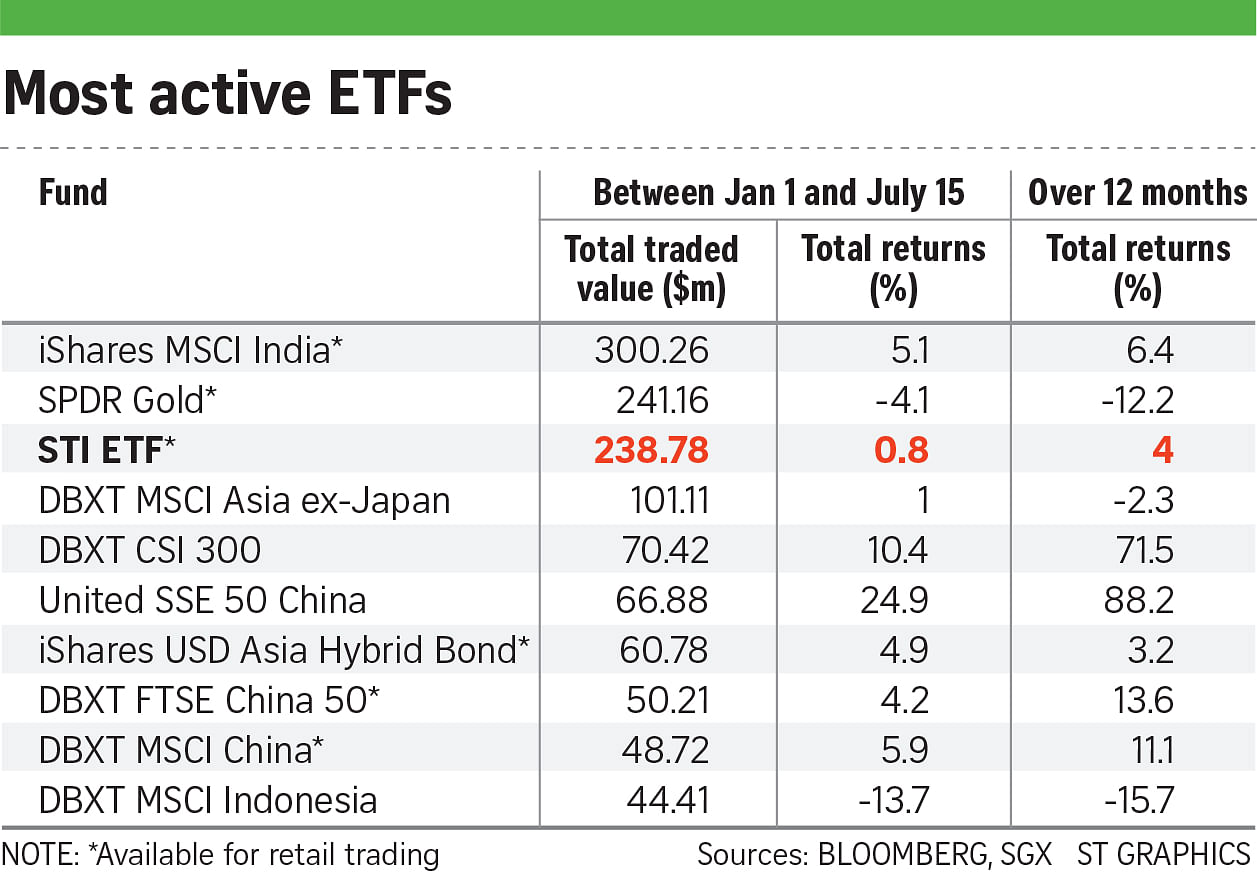Index-tracking funds are enjoying a revival as investor appetite for regional equities grows.
Trading in such exchange-traded funds (ETFs) rose 39.4 per cent to $1.51 billion in the first half, from $1.08 billion in the same period last year. In contrast, the total turnover on the Singapore Exchange (SGX) inched up 6.2 per cent to $145.66 billion in the six months to June 30.
This marks a remarkable about-turn from the past three years when ETF activity declined. Total ETF turnover had fallen by 27.7 per cent last year to $2.35 billion from 2013's $3.25 billion, which was itself a 37 per cent drop from $5.16 billion in 2012.
What accounts for the pick-up in ETF interest?
Globally, ETFs have become a hot asset, with investors pouring a record US$152 billion (S$207 billion) into them in the first half, and pushing the total sum invested in such funds to US$2.97 trillion.
The big attraction is that ETFs provide a cheaper alternative to many of the investments offered by professional fund managers, by pooling money from investors to buy into baskets of stocks that replicate widely watched market barometers such as Wall Street's S&P 500 Index.

ETFs are also traded like stocks on bourses like SGX, which makes it easier for investors to buy and sell them, unlike unit trusts where they may have to wait until the close of the business day to get a price.
Until recently, most ETFs were off-limits to retail investors in Singapore unless they took a financial literacy test.
This is because ETFs are regarded as more complicated investments that may employ derivatives to juice up their returns, making them unsuitable for retail investors who may not understand what they are dabbling in.
However, Singapore regulators had a change of heart in April, tweaking the rule to allow ETFs that make limited use of derivatives to be made more accessible to retail investors.
The upshot is that the number of ETFs that retail investors can trade without getting tested has more than doubled - from nine to 19 - in the space of two months. That makes up one-fifth of the 87 ETFs listed in Singapore.
The move has given ETF trading a big shot in the arm. SGX data shows that six of the 10 most actively traded ETFs are those open to retail investors who do not need to take a test. They include ETFs that give investors access to red-hot markets such as Shanghai and Mumbai, where daily trading activities have far surpassed the SGX's, as well as exposure to precious metals such as gold and safe fixed-income assets like bonds.
The regional ETFs also give an investor a much-needed alternative to diversify out of the Singapore market. If he had merely invested in a fund tracking the Straits Times Index, he would have made a measly 0.8 per cent return on his investment this year.
If he had ventured further afield, the returns would have been much richer. For example, investing in the iShares MSCI India ETF - tracking the Mumbai stock market - would have yielded a 5.1 per cent return for this year.
Buying the United SSE 50 China ETF - which tracks 50 blue chips traded in Shanghai - in the same period would have given him a handsome return of 24.9 per cent, even after the recent stock market turmoil in China.
Still, it is unlikely that even with the revival in ETF activities, total trading in these instruments this year will reach the levels encountered in 2011, when transactions hit $9.93 billion - the year before most ETFs were put out of retail investors' reach.
As it is, many investors are still under the impression that they cannot trade ETFs without passing the financial literacy test. Little is being done to correct this erroneous impression.
There is also no incentive for remisiers, who rely on clients' large volumes of orders for their commission-based income, to promote ETFs, which tend to draw buy-and-hold type of investors.
Most ETFs charge a management fee of 0.25 per cent to 0.3 per cent, compared with the 1 per cent to 2 per cent levied by unit trusts.
That gives ETF providers little room to offer big commissions to banks and other intermediaries such as brokerages to try to push the product to their clients.
To promote ETFs as investment products, the SGX has waived clearing fees on such trades till the end of the year.
And ETF providers are making education a top priority as they partner the SGX in reaching out to investors.
Mr Marco Montanari, head of passive asset management at Deutsche Asset & Wealth Management, said: "We have co-organised several investor- education conferences in partnership with SGX. The upcoming initiative is to present 'How to Access the China market with ETFs in the SGX Academy' later this month."
Deutsche Bank's offerings make up 10 of the 19 ETFs available for retail trading.
But to further build up the buzz in ETF trading, the SGX should lend another helping hand by encouraging other ETF providers to join the effort as well, and offer retail investors more choices.
As the former SGX chief Magnus Bocker noted, interest is only built up once a critical mass of products is available. "It is like Orchard Road. If you have a lot of shops, you will find a lot of people going there," he once said.
ETFs have taken off like wildfire elsewhere as they offer a cheap low-risk route for investors to buy into a basket of stocks without worrying about their investments going up in smoke. It would be a great pity if ignorance continues to keep them out of reach of investors in Singapore.

